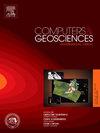PyHawk: An efficient gravity recovery solver for low–low satellite-to-satellite tracking gravity missions
IF 4.4
2区 地球科学
Q1 COMPUTER SCIENCE, INTERDISCIPLINARY APPLICATIONS
引用次数: 0
Abstract
The low–low satellite-to-satellite tracking (LL-SST) gravity missions, such as the Gravity Recovery and Climate Experiment (GRACE) and its Follow-On (GRACE-FO), provide an important space-based Essential Climate Variable (ECV) to measure changes in the Terrestrial Water Storage (TWS). Due to the high-precision Global Navigation Satellite System (GNSS) receiver, accelerometers, and inter-satellite ranging instrument, these LL-SST missions are able to sense extremely tiny perturbations on both the orbit and inter-satellite ranges, which can project into the Earth’s time-variable gravity fields. The measurement systems of these LL-SST missions are highly complex; therefore, a data processing chain is required to exploit the potential of their high-precision measurements, which challenges both general and expert users. In this study, we present an open-source, user-friendly, cross-platform and integrated toolbox “PyHawk”, which is the first Python-based software in relevant field, to address the complete data processing chain of LL-SST missions including GRACE, GRACE-FO and probably the future gravity missions. This toolbox provides non-expert users an easy access to the payload data pre-processing, background force modeling, orbit integration, ranging calibration, as well as the ability for temporal gravity field recovery using LL-SST measurements. In addition, a series of high-standard benchmark tests have been provided to evaluate PyHawk, confirming its performance to be comparable with those used to provide the official Level-2 time-variable gravity field solutions of GRACE. Researchers working with orbit determination and gravity field modeling can benefit from this toolbox.
PyHawk:用于低-低卫星对卫星跟踪重力任务的有效重力恢复求解器
重力恢复与气候实验(GRACE)及其后续(GRACE- fo)等低空卫星对卫星跟踪(LL-SST)重力任务为测量陆地储水量(TWS)变化提供了重要的天基基本气候变量(ECV)。由于高精度的全球导航卫星系统(GNSS)接收器、加速度计和星间测距仪,这些LL-SST任务能够感知轨道和星间范围上极其微小的扰动,这些扰动可以投射到地球的时变重力场中。这些LL-SST任务的测量系统非常复杂;因此,需要一个数据处理链来开发其高精度测量的潜力,这对普通用户和专家用户都是一个挑战。在这项研究中,我们提出了一个开源、用户友好、跨平台的集成工具箱“PyHawk”,这是相关领域第一个基于python的软件,用于解决包括GRACE、GRACE- fo以及未来重力任务在内的LL-SST任务的完整数据处理链。该工具箱为非专业用户提供了一个轻松访问有效载荷数据预处理、背景力建模、轨道集成、测距校准以及使用LL-SST测量恢复时间重力场的能力。此外,还提供了一系列高标准的基准测试来评估PyHawk,证实其性能可与提供GRACE官方2级时变重力场解的测试相媲美。从事轨道确定和重力场建模的研究人员可以从这个工具箱中受益。
本文章由计算机程序翻译,如有差异,请以英文原文为准。
求助全文
约1分钟内获得全文
求助全文
来源期刊

Computers & Geosciences
地学-地球科学综合
CiteScore
9.30
自引率
6.80%
发文量
164
审稿时长
3.4 months
期刊介绍:
Computers & Geosciences publishes high impact, original research at the interface between Computer Sciences and Geosciences. Publications should apply modern computer science paradigms, whether computational or informatics-based, to address problems in the geosciences.
 求助内容:
求助内容: 应助结果提醒方式:
应助结果提醒方式:


